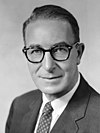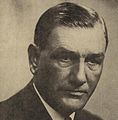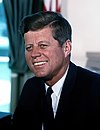1956 Democratic National Convention
hideThis article has multiple issues. Please help or discuss these issues on the talk page. (Learn how and when to remove these template messages)
|
| 1956 presidential election | |
  Nominees Stevenson and Kefauver | |
| Convention | |
|---|---|
| Date(s) | August 13–17, 1956 |
| City | Chicago, Illinois |
| Venue | International Amphitheatre |
| Keynote speaker | Gov. Frank G. Clement of Tennessee |
| Candidates | |
| Presidential nominee | Adlai Stevenson of Illinois |
| Vice presidential nominee | Estes Kefauver of Tennessee |




The 1956 Democratic National Convention nominated former Governor Adlai Stevenson of Illinois for president and Senator Estes Kefauver of Tennessee for vice president. It was held in the International Amphitheatre on the South Side of Chicago, Illinois August 13–August 17, 1956. Unsuccessful candidates for the presidential nomination included Governor W. Averell Harriman of New York, Senator Lyndon B. Johnson of Texas, and Senator Stuart Symington of Missouri.
As the unsuccessful 1952 Democratic Party presidential nominee, Stevenson had the highest stature of the active candidates and was easily renominated on the first ballot. Former President Harry S. Truman, whose support for Stevenson in '52 helped secure him the nomination, was opposed to his renomination in 1956, instead favoring Harriman. It did no good, as Truman was no longer a sitting President, and Stevenson was nominated on the first ballot.
After Stevenson decided not to reselect his 1952 running mate John Sparkman, the convention was marked by a "free vote" for the vice presidential nomination in which the winner, Kefauver, defeated Senator John F. Kennedy of Massachusetts. The vice presidential nomination vote, which required three separate ballots, was (as of 2020) the last multi-balloted contest held at a quadrennial political convention of any major U.S. political party for the presidency or vice presidency.
The Democratic convention preceded the 1956 Republican convention in the Cow Palace, San Francisco, California. At the GOP gathering, President Dwight D. Eisenhower and Vice President Richard Nixon were nominated for reelection.
Scheduling of convention[]
The 1956 Democratic convention was held before that year's Republican National Convention. This was unusual, as since 1864, in every election but 1888, Democrats had held their convention second.[1] It has become an informal tradition that the party holding the White House (which, accordingly, in 1956 had been the Republican Party) hosts their convention second, but it is unclear when this tradition began (Democrats had held the White House and held their conventions second between 1936 and 1952, but it is unclear whether they scheduled their conventions second in these years because of their White House incumbency, or whether they scheduled them second because it was traditional that Democratic National Conventions had been held after the Republican National Convention).[1]
This was only the second convention to be televised live coast-to-coast. Television had, by 1956, become the dominant medium of popular news coverage. To adjust to the medium of television, the convention was condensed in length compared to previous years, with daytime sessions being largely eliminated and the amount of welcoming speeches and parliamentary organization speeches being decreased (such as seconding speeches for vice-presidential candidates, which were eliminated). Sessions were also scheduled in order to maximize exposure to prime-time audience.[2]
The 1956 Democratic Platform[]
With regard to the growing Civil Rights Movement, the platform called for voting rights, equal employment opportunities, and the desegregation of public schools. Relative to the Republicans, the Democrats favored greater reliance on the United Nations, multilateral disarmament, more spending for programs relating to social welfare and agriculture, "a full and integrated program of development, protection, management and conservation of natural resources," and the use of peaceful atomic energy.
Presidential nomination[]
Candidates:

Former Governor Adlai Stevenson of Illinois

Governor W. Averell Harriman of New York

Senator Lyndon B. Johnson of Texas

Senator Stuart Symington of Missouri

Governor Happy Chandler of Kentucky

Former Governor John S. Battle of Virginia
The roll call, as reported in Richard C. Bain and Judith H. Parris, Convention Decisions and Voting Records, pp. 294–298:
| Presidential Balloting, DNC 1956 | |
|---|---|
| Contender | Vote |
| Former Illinois Governor Adlai Stevenson | 905.5 (65.9%) |
| New York Governor W. Averell Harriman | 210 (15.31%) |
| Senate Majority Leader Lyndon B. Johnson of Texas | 80 (5.83%) |
| Missouri Senator Stuart Symington | 45.5 (3.32%) |
| Kentucky Governor Happy Chandler | 36.5 (2.66%) |
| Georgia Congressman James C. Davis | 33 (2.41%) |
| Former Virginia Governor John S. Battle | 32.5 (2.37%) |
| South Carolina Governor George Bell Timmerman | 23.5 (1.71%) |
| Ohio Governor Frank J. Lausche | 5.5 (0.4%) |
Vice Presidential nomination[]
The highlight of the 1956 Democratic Convention came when Stevenson, in an effort to create excitement for the ticket, made the surprise announcement that the convention's delegates would choose his running mate. This set off a desperate scramble among several candidates to win the nomination. A good deal of the excitement of the vice-presidential race came from the fact that the candidates had only one hectic day to campaign among the delegates before the voting began. The two leading contenders were Senator Kefauver, who retained the support of his primary delegates, and John F. Kennedy, who, as a first term Senator from Massachusetts, was relatively unknown at that point. Kennedy surprised the experts by surging into the lead on the second ballot; at one point he was only 15 votes shy of winning. However, a number of states then left their "favorite son" candidates and switched to Kefauver, giving him the victory. Kennedy then gave a gracious concession speech. The narrow defeat raised his profile and helped Kennedy's long-term presidential chances; by losing to Kefauver he avoided any blame for Stevenson's expected loss to Eisenhower in November. As of 2020, this was the last time any presidential or vice presidential nomination of either the Democratic or Republican parties, went past the first ballot.
Candidates

Senator Estes Kefauver of Tennessee

Senator John F. Kennedy of Massachusetts

Senator Hubert Humphrey of Minnesota

Mayor Robert F. Wagner, Jr. of New York City

Senator Albert Gore, Sr. of Tennessee

Senator Clinton Presba Anderson of New Mexico

Governor Frank G. Clement of Tennessee

Governor LeRoy Collins of Florida

Governor Luther H. Hodges of North Carolina
The vote totals in the vice presidential balloting are recorded in the following table, which also comes from Bain & Parris.
| Vice Presidential Balloting, DNC 1956 | |||
|---|---|---|---|
| Contender: Ballot | 1 | 2 before shifts | 2 after shifts |
| Tennessee Senator Estes Kefauver | 466.5 | 551.5 | 755.5 |
| Massachusetts Senator John F. Kennedy | 294.5 | 618 | 589 |
| Tennessee Senator Albert Gore, Sr. | 178 | 110.5 | 13.5 |
| New York City Mayor Robert F. Wagner, Jr. | 162.5 | 9.5 | 6 |
| Minnesota Senator Hubert Humphrey | 134 | 74.5 | 2 |
| North Carolina Governor Luther Hodges | 40 | 0.5 | 0 |
| Pitt Tyson Maner of Alabama | 33 | 0 | 0 |
| Florida Governor LeRoy Collins | 29 | 0 | 0 |
| New Mexico Senator Clinton Anderson | 16 | 0 | 0 |
| Tennessee Governor Frank G. Clement | 14 | 0 | 0 |
| California Attorney General Pat Brown | 1 | 0 | 0 |
| Texas Senator Lyndon B. Johnson | 1 | 0 | 0 |
| Missouri Senator Stuart Symington | 1 | 0 | 0 |
Election outcome[]
On November 6, Adlai Stevenson and Estes Kefauver lost the election to President Eisenhower and Vice President Nixon in a landslide.
See also[]
- 1956 Republican National Convention
- 1956 United States presidential election
- History of the United States Democratic Party
- 1956 Democratic Party presidential primaries
- List of Democratic National Conventions
- United States presidential nominating convention
References[]
- ^ Jump up to: a b "Whose Convention Goes First?". Slate Magazine. 3 August 2000. Retrieved 11 April 2020.
- ^ Jarvis, Sharon. "PRESIDENTIAL NOMINATING CONVENTIONS AND TELEVISION". www.museum.tv. Museum of Broadcast Communications. Retrieved April 1, 2017.
External links[]
- Democratic Party Platform of 1956 at The American Presidency Project
- Stevenson Nomination Acceptance Speech for President at DNC (transcript) at The American Presidency Project
- Video of Stevenson nomination acceptance speech for President at DNC (via YouTube)
- Audio of Stevenson nomination acceptance speech for President at DNC[permanent dead link]
- Video of Kefauver nomination acceptance speech for Vice President at DNC (via YouTube)
| Preceded by 1952 Chicago, Illinois |
Democratic National Conventions | Succeeded by 1960 Los Angeles, California |
- 1956 United States presidential election
- 1956 in Illinois
- 20th century in Chicago
- Political conventions in Chicago
- Democratic Party of Illinois
- Political events in Illinois
- Democratic National Conventions
- 1956 conferences
- August 1956 events



















